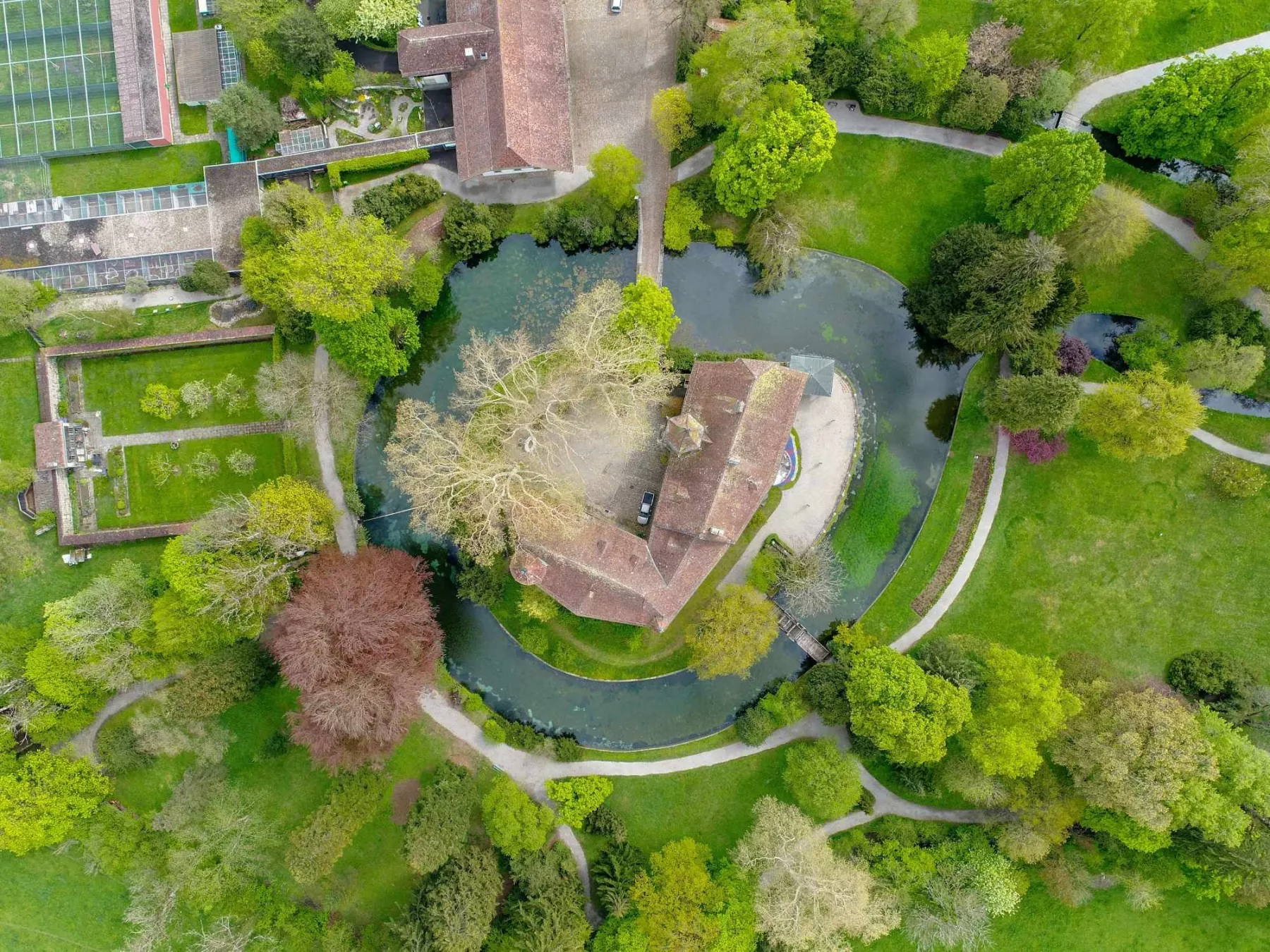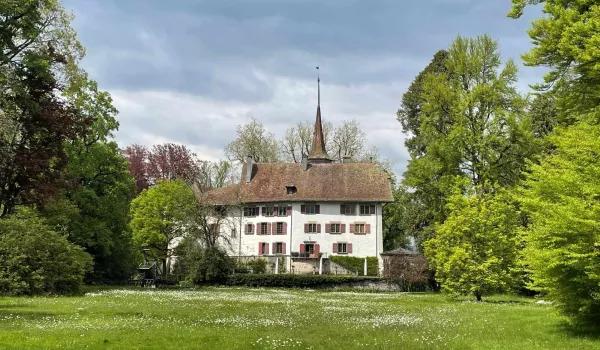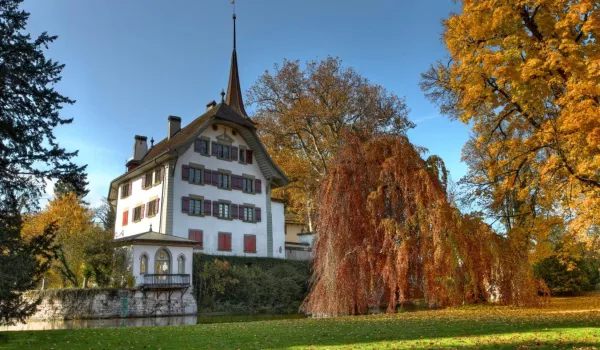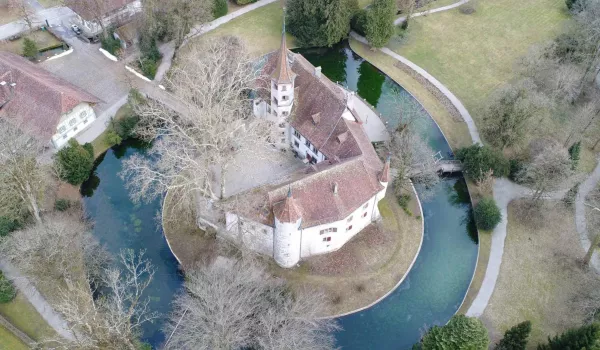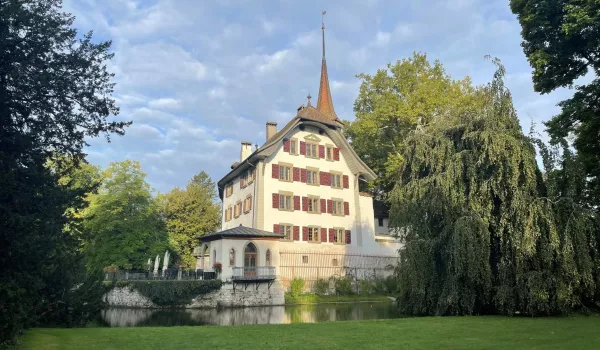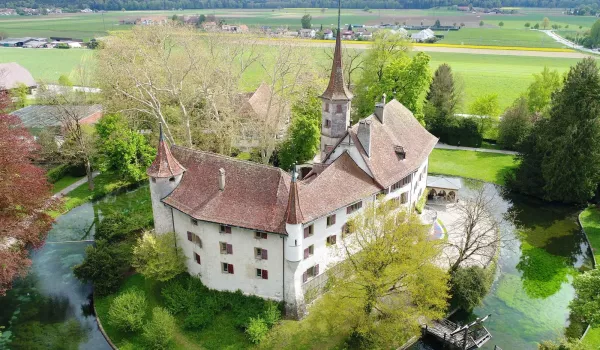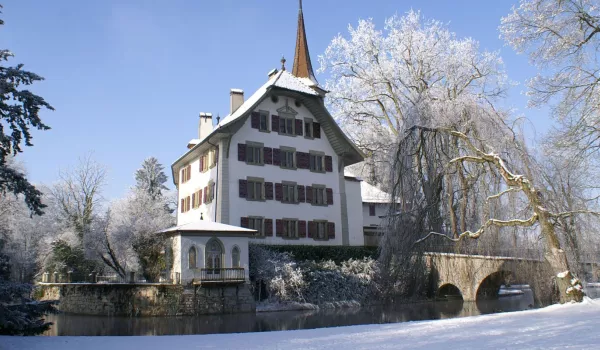Landshut Castle
Utzenstorf, BE
Landshut Castle is the only surviving moated castle in the canton of Bern and is set in the middle of magnificent parkland. Built on a sandstone hill, it rises above the former alluvial plains of the lower Emme. The castle and granary now house the Landshut Castle Museum and the Swiss Museum of Wildlife and Hunting.
Foundation of Landshut Castle
Finds from the Neolithic period provide evidence of early settlement in the fertile land on the lower Emme. Nothing is known about the history of the foundation of Landshut Castle and Palace. A county by the name of “Uranestorfus” is mentioned as early as 1009 in written documents. An original fortified site possibly already existed on the sandstone hill surrounded by water around the year 1000. The actual construction of a proper castle in Landshut began in the 2nd half of the 12th century. The castle itself is mentioned in documents in 1253 under the name “Landeshuothe” - hat or protection of the land.
From aristocratic residence to bailiff's castle
In the early 15th century, the Bernese councillor and mayor Rudolf von Ringoltingen (ca. 1385-1456) acquired the castle complex and expanded it. His son Thüring von Ringoltingen (ca. 1415-1483), also mayor of Bern and a talented writer, translated into German the French verse novel about the water fairy Melusina. Due to a lack of financial success, Thüring found himself forced to sell the castle and estate of Landshut to one of his sons-in-law.
In 1513, the Republic of Bern once more took charge of the castle and established the small bailiwick of Landshut, whose agriculture was highly profitable, and which included the present-day municipalities of Bätterkinden, Utzenstorf, Wiler and Zielebach. Until the end of the Ancien Régime in 1798, 55 bailiffs resided at Landshut Castle. Under Bailiff Abraham Jenner (1592-1632), the castle was extended on the existing foundations between 1624 and 1630.
The castle in private ownership
Landshut Castle took on its present form at the beginning of the 19th century. Niklaus Rudolf von Wattenwyl (1760-1832), former mayor of Bern and Landamman of Switzerland, bought the castle and transformed it according to his own plans. He created an idyllic country residence in the middle of an extensive park laid out in the English style. After many changes of ownership, the Canton of Bern finally acquired the entire estate in 1957.
Landshut Castle as a museum
At the end of the 1960s, the Swiss Museum of Wildlife and Hunting was established within the rooms of the castle.
Today, there are two museums share the castle and the granary: the Museum Castle Landshut and the Swiss Museum of Wildlife and Hunting. Both are run by the Landshut Castle Foundation, which has owned the castle since 1988.
In addition to the castle buildings and the landscaped park, the estate of Landshut Castle includes a stately residence and a farm building, which today houses the Landshut Castle Wildlife Station Foundation.
Seasonal duration
11 May to 12 October 2025
Museums and castle café
Tuesday to Saturday: 14:00 – 17:00
Sunday: 10:00 – 17:00
Closed: Mondays, Whit Monday, 01 August and Swiss National Day of Prayer
Winter break
The castle, the museums and the castle café are closed from mid-October to mid-May.
The castle park is freely accessible all year round.
Individuals
| Adults | CHF 7 |
| Adults reduced (AHV, IV) | CHF 6 |
| Adolescents up to 16 | CHF 1 |
| Children under 6 years | gratis |
Groups
| From 20 persons | CHF 6 per person |
Free admission
| Swiss Museum Pass |
| Members of the Swiss Museum of Wildlife and Hunting Society |
| Museums-Pass-Musée |
| ICOM/VMS |
| Raiffeisen (MemberPlus) |
Guided tours
Guided tours during the season can be booked with the castle warden.
Tel.: +41 (0)32 665 40 27
Mail: info@schlosslandshut.ch
| During opening hours | CHF 100 plus museum entrance fee |
| Outside opening hours | CHF 150 plus museum entrance fee |
Max. 25 persons per guide, duration of the tour approx. 1 hour, last tour at 17:00.
The moated castle in the lower Emmental is an ideal destination for families, nature lovers, those seeking relaxation and hunters.
The castle park is freely accessible all year round. Visitors are requested to stay on the paths.
Dogs on a leash are welcome in the park and in the castle café. They are not allowed in the museum.
Two parking spaces are available for bicycles.
The castle café and the special exhibition are wheelchair accessible. There is a barrier-free toilet in the temporary exhibition room. People with reduced mobility may park in the deliveries parking area in front of the Wildlife Station. Please place a sign on your vehicle or speak with the castle wardens.
The castle café with 30 seats is located in the castle courtyard under three large plane trees. Visitors are welcome to enjoy hot or cold drinks and snacks in this idyllic setting.
Restaurants nearby:
Restaurant zum Schloss Landshut, Utzenstorf
Landgasthof Bären, Utzenstorf
Restaurant La Rôtisseria, Utzenstorf
Restaurant Freischütz, Utzenstorf
Restaurant Rössli, Utzenstorf
For hire
Conferences: At Landshut Castle, conferences and meetings for up to 65 people can be held in the conference hall in the Economics building (all year round) and meetings for up to 16 people in the castle (during the season). Details here (in English).
Weddings: for wedding parties, see parties. It is not possible to hold a civil wedding at Landshut Castle.
Parties: Whether in the Banqueting hall, on the garden terrace or in the castle cellar, at Landshut Castle parties can be celebrated in a unique environment.
The banqueting hall and the garden terrace can both be hired during the season. For banquets in the Banqueting hall, the restauranteurs and caterers are specified by the Landshut Castle Foundation. Information on +41 (0)32 665 40 27.
Banquet and drinks hire:
Banquets in the hall for up to 70 people
Drinks in the hall for up to 100 people
Drinks on the garden terrace for up to 100 people (bad weather alternative: ballroom).
Details here (in English).
The castle courtyard and cellar are ideal for drinks and meals in a unique setting: weddings, birthdays, anniversaries, seminars and much more. A well-equipped kitchen is available in the cellar. Crockery, glasses and cutlery are available, but no cooking utensils.
Cellar hire: Banquets for up to 50 people and drinks for up to 70 people. The cellar can be heated and can be hired out all year round, except on Sundays.
Drinks in the courtyard for up to 120 people (Wildlife Station conference hall in bad weather).
Lectures, themed guided tours and public events are held regularly at Landshut Castle. They are always published on the castle website.
Arrival
Schloss Landshut
Schlossstrasse 17
3427 Utzensdorf
By train
Utzenstorf or Bätterkinden train station.
From Utzenstorf station: 10 minutes on foot (road) or approx. 20 minutes (hiking trail)
From Bätterkinden station: 20 minutes on foot, partly on footpath.
by car
Highway A1 from Bern: Exit Kirchberg (No. 39); Highway A1 from Basel/Zurich: exit Kriegstetten (No. 40). There is a large carpark at the southern entrance to the park.
Arrival with Google Maps
